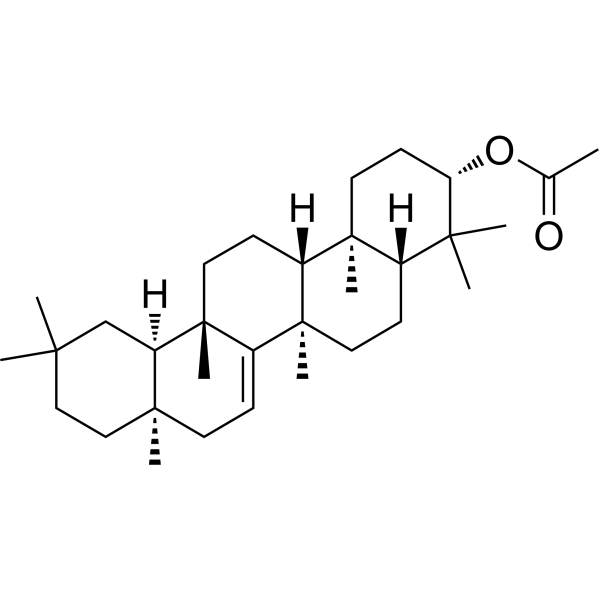
Taraxeryl acetate
CAS No. 2189-80-2
Taraxeryl acetate( —— )
Catalog No. M30896 CAS No. 2189-80-2
Taraxeryl acetate shows the significant antiviral activity against herpes simplex virus (type II). It has less effect on cell cycle arrest and apoptosis of AGS cells than taraxerol.
Purity : >98% (HPLC)
 COA
COA
 Datasheet
Datasheet
 HNMR
HNMR
 HPLC
HPLC
 MSDS
MSDS
 Handing Instructions
Handing Instructions
| Size | Price / USD | Stock | Quantity |
| 5MG | 209 | In Stock |


|
| 50MG | Get Quote | In Stock |


|
| 100MG | Get Quote | In Stock |


|
Biological Information
-
Product NameTaraxeryl acetate
-
NoteResearch use only, not for human use.
-
Brief DescriptionTaraxeryl acetate shows the significant antiviral activity against herpes simplex virus (type II). It has less effect on cell cycle arrest and apoptosis of AGS cells than taraxerol.
-
DescriptionTaraxeryl acetate shows the significant antiviral activity against herpes simplex virus (type II). It has less effect on cell cycle arrest and apoptosis of AGS cells than taraxerol. A. roxburghiana has antidiabetic activity, could be attributed due to PTP1B inhibition by its triterpene constituents, betulin, betulinic acid and Taraxeryl acetate.
-
In VitroTaraxerol acetate(10-150?μM; 24 or 48 hours)induces a dose- and time-dependent cytotoxic effects in the U87 cells, exhibits IC50 values of 34.2 and 28.4?μM, at 24 and 48 h, respectively.Taraxerol acetate(10, 50 and 150?μM; 24 hours)induces cell apoptosis, the percentage of apoptotic cells increased from 7.3% in the control cells, to 16.1, 44.1 and in the 10, 50 and 150?μM taraxerol acetate-treated cells, respectively. Furthermore, taraxerol acetate treatment led to sub-G1?cell cycle arrest with a corresponding decrease in the number of S-phase cells.
-
In Vivo——
-
Synonyms——
-
PathwayOthers
-
TargetOther Targets
-
Recptor——
-
Research Area——
-
Indication——
Chemical Information
-
CAS Number2189-80-2
-
Formula Weight468.8
-
Molecular FormulaC32H52O2
-
Purity>98% (HPLC)
-
Solubility——
-
SMILES——
-
Chemical Name——
Shipping & Storage Information
-
Storage(-20℃)
-
ShippingWith Ice Pack
-
Stability≥ 2 years
Reference
molnova catalog



related products
-
p34cdc2 - derived pe...
p34cdc2 - derived peptide
-
Ibutamoren
Ibutamoren is a drug which acts as a potent, orally active growth hormone secretagogue, mimicking the GH stimulating action of the endogenous hormone ghrelin.
-
Spermine
A biogenic polyamine formed from spermidine. It is found in a wide variety of organisms and tissues and is an essential growth factor in some bacteria.



 Cart
Cart
 sales@molnova.com
sales@molnova.com


